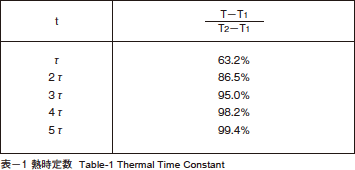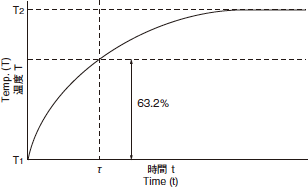Thermal Time ConstantNTC Thermistors
A constant expressed as the time for the temperature at the element of a thermistor, with no load applied, to change to 63.2% of the difference between their initial and final temperatures, during a sudden change in the surrounding temperature.
When the surrounding temperature of the thermistor changes from T1 to T2, the relation between the elapsed time t and the thermistors temperature T can then be expressed by the following equation. by ambient temperature change.
\[ \begin{eqnarray} T&=& \begin{pmatrix} T_1 - T_2 \end{pmatrix} exp \begin{pmatrix} -t / \tau \end{pmatrix} +T_2 \qquad \qquad・・・(3.1) \\[8px] &=& \begin{pmatrix} T_2 - T_1 \end{pmatrix} \begin{Bmatrix} 1-exp \begin{pmatrix} -t / \tau \end{pmatrix} \end{Bmatrix} +T_1 \qquad ・・・(3.2) \end{eqnarray} \]
The constant τ is called the heat dissipation constant.
If \( t = \tau \), the equation becomes: \( \begin{pmatrix} T - T_1 \end{pmatrix} / \begin{pmatrix} T_2 - T_1 \end{pmatrix} \fallingdotseq 0.632 \)
In other words, the above definition states that the thermal time constant is the time it takes for the temperature of the thermistor to change by 63.2% of its initial temperatrue difference.
The rate of change of the thermistor temperature versus time is shown in table 1.
Measuring conditions for parts in this catalog are as follows:
- Part is moved from a 50 ̊C envirconment to a still air 25 ̊C environment until the temperature of the thermistor reaches 34.2 ̊C.
- Axial and radial leaded parts are measured in their shipping form.
Please note, the thermal dissipation constant and thermal time constant will vary according to environment and mounting condition


